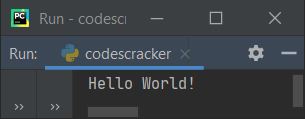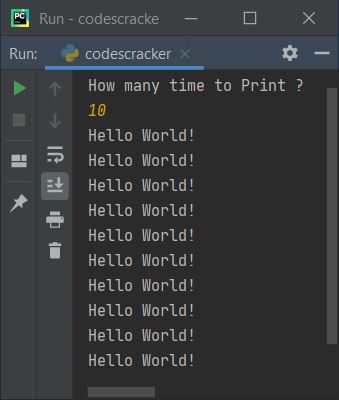- Python Basic Programs
- Python Program Examples
- Python Print Hello World
- Python Get Input from User
- Python Add Two Numbers
- Add Subtract Multiply Divide
- Python Check Even or Odd
- Python Check Prime or Not
- Python Check Alphabet or Not
- Python Check Vowel or Not
- Python Check Leap Year or Not
- Check Reverse equal Original
- Check Positive Negative Zero
- Python Check Armstrong or Not
- Python Check Palindrome or Not
- Python Check Perfect Number
- Python Find Reverse of Number
- Python Count Digits in Number
- Python Add Digits of Number
- Sum of First and Last Digits
- Python Product of Mid Digits
- Sum of Squares of Digits
- Interchange Digits of Number
- Python Sum of n Numbers
- Python Print ASCII Values
- Python Swap Two Numbers
- Python Swap Two Variables
- Python Fahrenheit to Celsius
- Python Celsius to Fahrenheit
- Python Display Calendar
- Python Days into Years, Weeks
- Find Largest of Two Number
- Find Largest of Three Number
- Python Print Fibonacci Series
- Generate Armstrong Numbers
- Python Make Simple Calculator
- Python Add Binary Numbers
- Binary Number Multiplication
- Python Mathematical Programs
- Find Sum of Natural Numbers
- Find Average of n Numbers
- Python Print Multiplication Table
- Print Table using Recursion
- Python Find Average Percentage
- Python Find Grade of Student
- Find Square Root of Number
- Python Print Prime Numbers
- Find Numbers Divisible by
- Python Find Factors of Number
- Python Find Factorial of a Number
- Python Find HCF & LCM
- Python Kilometres to Miles
- Python Find Area of Square
- Python Find Area of Rectangle
- Python Find Area of Triangle
- Python Find Area of Circle
- Python Find Perimeter of Square
- Find Perimeter of Rectangle
- Python Find Perimeter of Triangle
- Find Circumference of Circle
- Python Simple Interest
- Python Solve Quadratic Equation
- Python Different Set of Operations
- Python Display Powers of 2
- Python Find nCr & nPr
- Python Pattern Programs
- Python Print Pattern Programs
- Python Print Diamond Pattern
- Python Print Floyd's Triangle
- Python Print Pascal's Triangle
- Python List Programs
- Python Count Even/Odd in List
- Python Positive/Negative in List
- Python Even Numbers in List
- Python Odd Numbers in List
- Python Sum of Elements in List
- Sum of Odd/Even Numbers
- Python Element at Even Position
- Python Element at Odd Position
- Python Search Element in List
- Python Largest Number in List
- Python Smallest Number in List
- Python Second Largest in List
- Python Second Smallest in List
- Python Insert Element in List
- Python Delete Element from List
- Python Multiply Numbers in List
- Swap Two Elements in List
- Python 1D Array Program
- Python Linear Search
- Python Binary Search
- Python Insertion Sort
- Python Bubble Sort
- Python Selection Sort
- Remove Duplicates from List
- Python Reverse a List
- Python Merge Two List
- Python Copy a List
- Python Conversion Programs
- Python Decimal to Binary
- Python Decimal to Octal
- Python Decimal to Hexadecimal
- Python Binary to Decimal
- Python Binary to Octal
- Python Binary to Hexadecimal
- Python Octal to Decimal
- Python Octal to Binary
- Python Octal to Hexadecimal
- Python Hexadecimal to Decimal
- Python Hexadecimal to Binary
- Python Hexadecimal to Octal
- Python Matrix Programs
- Python Add Two Matrices
- Python Subtract Two Matrices
- Python Transpose Matrix
- Python Multiply Matrices
- Python String Programs
- Python Print String
- Python Find Length of String
- Python Compare Two Strings
- Python Copy String
- Python Concatenate String
- Python Reverse a String
- Python Swap Two Strings
- Python Uppercase to Lowercase
- Python Lowercase to Uppercase
- Python Check Substring in String
- Python Count Character in String
- Count Repeated Characters
- Python Count Word in Sentence
- Python Count Each Vowels
- Python Capitalize Character
- Python Capitalize Word in String
- Python Smallest/Largest Word
- Remove Spaces from String
- Remove Duplicate Character
- Remove Vowels from String
- Remove Punctuation from String
- Python Remove Word in String
- Python Remove Duplicate Words
- WhiteSpace to Hyphens
- Replace Vowels with Character
- Replace Character in String
- Python Sort String in Alphabetical
- Sort Word in Alphabetical Order
- Extract Number from String
- Python Check Anagram Strings
- Python File Programs
- Python Read a File
- Python Write to File
- Python Append Text to File
- Python Copy Files
- Python Merge Two Files
- Python Counts Characters in File
- Python Count Words in File
- Python File Content in Reverse
- Python Lines Contains String
- Python Delete Line from File
- Python Capitalize Word in File
- Python Replace Text in File
- Replace Specific Line in File
- Python Find Size of File
- Python List Files in Directory
- Python Delete Files
- Python Misc Programs
- Python Reverse a Tuple
- Python Merge Two Dictionary
- Python bytes to String
- Python bytearray to String
- Generate Random Numbers
- Python Print Address of Variable
- Python Print Date and Time
- Python Get IP Address
- Python Shutdown/Restart PC
- Python Tutorial
- Python Tutorial
Python Program to Print Hello World
In this article, I've created some programs in Python, to print Hello World. Here are the list of Hello World programs in Python:
- Simplest Hello World Program
- Print Hello World 5 times using for Loop
- Print Hello World n times. The value of n must be entered by user
- Print Hello World using Function
- Using Class and Object
Simplest Hello World Program in Python
To print "Hello World" in Python, use print() statement, and place "Hello World" inside it like done in the program given below. The question is, write a Python program to print Hello World!. Here is its answer:
print("Hello World!")
This Python program produces output as shown in the snapshot given below:

Note - The print() method output the thing present inside its braces. The thing may be directly string, or any object or variable etc.
The program given below, also prints Hello World, but not directly. That is, this program uses a variable named text that stores the string, and the string gets printed using print(). Let's have a look:
text = "Hello World!"
print(text)
This program produces exactly same output as of previous program.
Print Hello World 5 Times using for Loop
This program uses for loop to print five times Hello World.
for i in range(5): print("Hello World!")
Here is its sample output:

Note - Anything written after # (hash) symbol are comments. So compiler ignores it.
Note - The range() method returns a sequence of values. By default, starts with 0, increments by 1 each time, and continues before value provided as its argument.
Therefore, in above program, the value of i starts with 0 and continues upto 4, but when its value becomes equal to 5, means the condition evaluates to be false, and the program gets ended. In this way, the statement inside the loop, executes five times, so that, Hello World gets printed five times.
Print Hello World n Times
In this program, the string Hello World gets printed, upto given value. For example, if user enters 20, then program prints Hello World twenty times.
print("How many time to Print ? ") tot = int(input()) for i in range(tot): print("Hello World!")
Here is its sample run with user input 10 to print Hello World! ten times:

Note - If you're finding difficult to understand about the receiving of user inputs in Python, then leave the thing, and refer to Get Input from User, the next or second program of this Python programs series, to get every thing about the topic. After learning the thing about receiving user input, come back here to feel more comfortable to continue the series.
Modified Version of Previous Program
This is the modified version of previous program. The end= is used to skip inserting newline after the thing placed inside print(). The try-except is used to handle for invalid inputs.
while True: print("How many \"Hello World!\" to Print: ", end="") try: tot = int(input()) for i in range(tot): print("Hello World!") break except ValueError: print("\nInvalid Input!..Try Again!\n")
Here is its sample run with some invalid and valid inputs:

Since everything are placed inside a while loop and I've given the condition of while loop as a boolean value equals True. That means, the condition always evaluates to be true, therefore to exit the program, I've to use some keyword like break to terminate the execution of loop
The statement of try, that is:
tot = int(input())
states that, the code wants from user to enter an integer value only, but if user enters a number that is not a valid input (non-integer value, for example, floating-point, character, string etc.), then the code raises an error (ValueError), and program flow goes to its except's body and prints a message like Invalid Input!..Try Again!, and program flow again goes to the condition of while loop
Since the condition always evaluates to be true, therefore until user enters a valid input, the loop continues. That is, when user enters a correct value say 8, then Hello World gets printed eight times and then using break keyword, the loop's execution gets terminated.
Print Hello World using Function
This program uses a user-defined function to do the same job as of previous program. Let's have a look at the program first:
def myfun(): print("Hello World!") myfun()
produces exactly same output as of very first program's output of this article. Using the following statement:
myfun()
I've called the function, so compiler checks for this function. Since the function is already defined in this program using def keyword, therefore statement inside the function, that is:
print("Hello World!")
gets executed, that prints Hello World!.
Print Hello World using Class
This is the last program, created using a class named CodesCracker. Class is an object-oriented feature of Python.
class CodesCracker: def myfun(self): print("Hello World!") obj = CodesCracker() obj.myfun()
To access member function of a class say myfun(), we've to use an object of the class. Therefore an object named obj is created of class CodesCracker. And using this object, I've accessed the member function named myfun() using dot (.) operator.
Note - The self as first parameter is always required in every member function of a class in Python. It passes the object's address.
Same Program in Other Languages
« Previous Program Next Program »